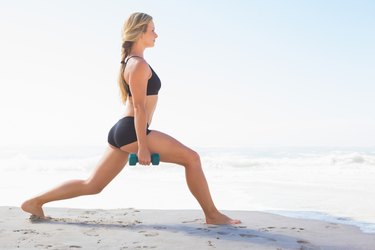
The human body is made up of hundreds of muscles, each classified as either skeletal, visceral or cardiac muscle tissue. Both flexors and extensors are skeletal muscles, and both have a unique function in the body relating to joint movement. Understanding what these muscles are, how they work and how to strengthen them can both add to and improve your daily workout routine.
Flexors and Extensors: What Make Them Skeletal Muscles
Video of the Day
It's important to first understand what defines a skeletal muscle. Skeletal muscles are found on the bone, interact with bones for movement and are voluntarily controlled. When performing a workout, we activate the body's skeletal muscle groups to create movement and burn calories. Flexors and extensors are at the core of this. Together, they bend and straighten the body's joints to create motion and activate other muscle groups, generating muscle activity -- which is another way to say working out.
Video of the Day
How Flexors Work
Flexors work to bend a joint. You may recognize a common exercise term right in the word "flex." When you flex your muscles, your flexors contract and pull on the bone, creating a bending movement of the joint. Try imagining a bicep curl. As you pull your fist upward to your shoulder, the angle between your forearm and bicep decreases as the flexor muscle tightens and contracts.
How Extensors Work
Extensors serve the opposite purpose -- extending and straightening joints. In a bicep curl, the extensor muscles contract as the fist is let down from the shoulder. The same occurs with walking or running, as hip extensors contract and pull the thigh back to the anatomical position.
Strengthening Flexors and Extensors
By virtue of generating the movement of exercise, flexor and extensor muscles already benefit from your regular routine. You can, however, target specific groups of flexors and extensors. For example, try performing barbell wrist curls and palm press stretches to work out wrist flexors and extensors. Stretching and strengthening these muscles can relieve the stiffness and soreness that can occur when muscles are weakened or overworked.